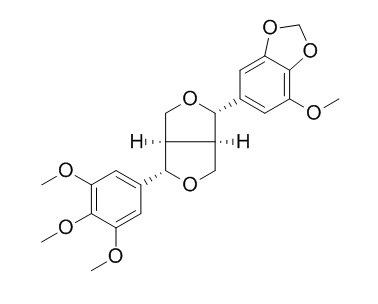Sesartemin
Reference standards.
Inquire / Order:
manager@chemfaces.com
Technical Inquiries:
service@chemfaces.com
Tel:
+86-27-84237783
Fax:
+86-27-84254680
Address:
1 Building, No. 83, CheCheng Rd., Wuhan Economic and Technological Development Zone, Wuhan, Hubei 430056, PRC
Providing storage is as stated on the product vial and the vial is kept tightly sealed, the product can be stored for up to
24 months(2-8C).
Wherever possible, you should prepare and use solutions on the same day. However, if you need to make up stock solutions in advance, we recommend that you store the solution as aliquots in tightly sealed vials at -20C. Generally, these will be useable for up to two weeks. Before use, and prior to opening the vial we recommend that you allow your product to equilibrate to room temperature for at least 1 hour.
Need more advice on solubility, usage and handling? Please email to: service@chemfaces.com
The packaging of the product may have turned upside down during transportation, resulting in the natural compounds adhering to the neck or cap of the vial. take the vial out of its packaging and gently shake to let the compounds fall to the bottom of the vial. for liquid products, centrifuge at 200-500 RPM to gather the liquid at the bottom of the vial. try to avoid loss or contamination during handling.
Virulence.2018, 9(1):588-603
Evid Based Complement Alternat Med.2022, 9767292,2.
Anim Cells Syst (Seoul).2024, 28(1):381-391.
ACS Nano.2023, 17(11):9972-9986.
Thorac Cancer.2023, 14(21):2007-2017.
Plants (Basel).2021, 10(11):2525.
J Adv Res.2021, 35:245-257.
Front Cell Dev Biol.2021, 9:638174.
PLoS One.2018, 13(4):e0195642
Phytochemistry2018, 15:83-92
Related and Featured Products
Phytochemistry. 2017 Mar;135:181-190
Sensory active piperine analogues from Macropiper excelsum and their effects on intestinal nutrient uptake in Caco-2 cells.[Pubmed:
28065397]
The phytochemical profile of Macropiper excelsum (G.Forst.) Miq. subsp. excelsum (Piperaceae), a shrub which is widespread in New Zealand, was investigated by LC-MS-guided isolation and characterization via HR-ESI-TOF-MS and NMR spectroscopy.
METHODS AND RESULTS:
The isolated compounds were sensorily evaluated to identify their contribution to the overall taste of the crude extract with sweet, bitter, herbal and trigeminal impressions. Besides the known non-volatile Macropiper compounds, the lignans (+)-diayangambin and (+)-excelsin, four further excelsin isomers, (+)-diaSesartemin, (+)-Sesartemin, (+)-epiSesartemin A and B were newly characterized. Moreover, piperine and a number of piperine analogues as well as trans-pellitorine and two homologues, kalecide and (2E,4E)-tetradecadienoic acid N-isobutyl amide were identified in M. excelsum, some of them for the first time. Methyl(2E,4E)-7-(1,3-benzodioxol-5-yl)hepta-2,4-dienoate was identified and characterized for the first time in nature.
CONCLUSIONS:
Sensory analysis of the pure amides indicated that they contributed to the known chemesthetic effects of Macropiper leaves and fruits. Since the pungent piperine has been shown to affect glucose and fatty acid metabolism in vivo in previous studies, piperine itself and four of the isolated compounds, piperdardine, chingchengenamide A, dihydropiperlonguminine, and methyl(2E,4E)-7-(1,3-benzodioxol-5-yl)hepta-2,4-dienoate, were investigated regarding their effects on glucose and fatty acid uptake by enterocyte-like Caco-2 cells, in concentrations ranging from 0.1 to 100 μM. Piperdardine showed the most pronounced effect, with glucose uptake increased by 83 ± 18% at 100 μM compared to non-treated control cells. An amide group seems to be advantageous for glucose uptake stimulation, but not necessarily for fatty acid uptake-stimulating effects of piperine-related compounds.
J Ethnopharmacol. 1984 Oct;12(1):75-92.
An ethnopharmacological examination of Virola elongata bark: a South American arrow poison.[Pubmed:
6097773]
The use of the resin of Virola elongata as an arrow poison was investigated.
METHODS AND RESULTS:
Aqueous and methanolic extracts of the dried bark were not observed to have toxic effects when administered intraperitoneally to mice. In an attempt to determine if the hallucinogenic indole alkaloid constituents of the bark, which form the basis for the alternate use of this material as a ceremonial snuff, could also be responsible for its use as an arrow poison, alkaloidal and non-alkaloidal extracts were compared with respect to their behavioral effects on mice. The non-alkaloidal extract was more effective in producing an observable alteration in behavior. This consisted of a marked reduction in spontaneous locomotor activity. The extract was fractionated and 13 of the major constituents assayed for their ability to reduce spontaneous locomotor activity.
CONCLUSIONS:
Most of this biological activity of the extract was attributable to the presence of the bis-tetrahydrofuran lignans, epi-Sesartemin, Sesartemin, epi-yangambin and yangambin. Each of these compounds was also observed to reduce isolation induced aggression when administered to mice.



